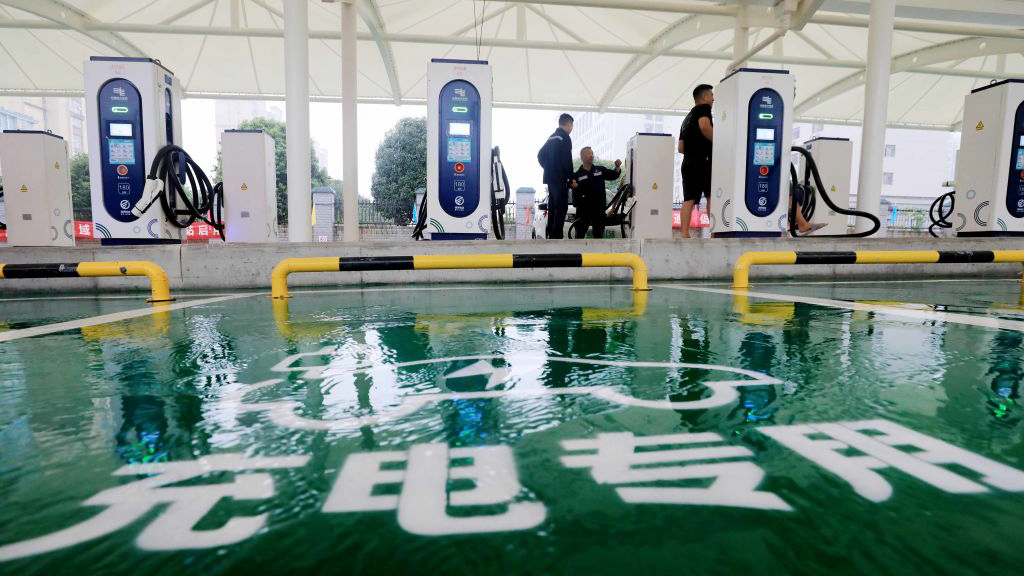
A citizen uses a flexible charging heap to charge an electric vehicle at a comprehensive energy service station in Liuzhou City, Guangxi Zhuang Autonomous Region, China, July 1, 2021. /Getty
A citizen uses a flexible charging heap to charge an electric vehicle at a comprehensive energy service station in Liuzhou City, Guangxi Zhuang Autonomous Region, China, July 1, 2021. /Getty
Editor's note: Stephen Ndegwa is a Nairobi-based communication expert, lecturer-scholar at the United States International University-Africa, author and international affairs columnist. The article reflects the author's opinions and not necessarily the views of CGTN.
Due to lack of widespread awareness, sustainable transport sounds like a new concept. The world's billions wake up every day and go about their business without giving much thought to the impact their modes of transport have on the environment. Well, from now on there will be no excuse as the consequences of carbon emissions from motor engines have been fully documented.
Transport has become the leading emitter of carbon emissions over other energy-consuming sectors; but it is not just the environment that has suffered from the current transport system. Hundreds of thousands of lives are lost every year from road crashes.
Many people also suffer from ill health caused by physical inactivity due to dependence on motor transport. Gridlock also has a high economic cost as people spend several hours each day on traffic jams coupled with delays in delivery of goods.
Interestingly, on the sidelines of the ongoing United Nations Biodiversity Conference in Kunming in China, the capital city Beijing is hosting the Second United Nations Global Sustainable Transport Conference between October 14 and 16. There could have been some indecisiveness on how to shape the global transport system owing to the fact that the first Global Sustainable Transport Conference was held in 2016 in Turkmenistan.
The agenda of the forum is basically an environmental matter. The international delegates are exploring ways of aligning transport to the objectives of the 2030 Agenda for Sustainable Development, and the Paris Agreement on climate change in the Decade of Action. It is about keeping the opportunity cost of the world's transport system below the environmental damage threshold and ensuring that it is cyclical in its operation.
But sustainable transport is not simply about halting the carbon footprint. Measures must be sensitive to the fact that billions of livelihoods depend on different modes of fuel-based transport.
While rich individuals and countries can afford new modes of transport that do not pollute the environment, this is still a privilege that the poor can ill afford due to the steep initial investment. The high cost of transforming the traditional systems of transport cannot be overlooked.
The COVID-19 pandemic has brought the world a few crucial lessons in the management of time and space. During the height of movement restrictions by governments, life shifted online. Both national and international meets were held virtually, which drastically reduced in-person interactions and the attendant carbon emissions from land, sea and air transport.
Although it offered a temporary respite, this was definitely a boon for the ozone layer even as there are fears that emissions will soon revert to pre-COVID19 levels.
But it also came to our realization that transport operates in a massive social context. Daily movement both in-country and overseas enabled people-to-people exchanges in various fields including education, sports, religious observances, modern and traditional festivals and ceremonies. The impact on mental health borne out of human isolation is now becoming evident with the spiraling of anti-social behaviors globally.
Since it is not possible to return to the use of oxen and other rudimentary green means of transport, we must as a matter of necessity innovate. Already, a lot of work has been done by developed countries, including major developing ones like China. The latter has become a best practice in clean transport vehicles as it moves ambitiously towards achieving carbon neutrality by 2060.

Workers assemble electric vehicles on a production line at the final assembly workshop of Haima Automobile in Haikou, Hainan Province, south China, August 23, 2021. /Getty
Workers assemble electric vehicles on a production line at the final assembly workshop of Haima Automobile in Haikou, Hainan Province, south China, August 23, 2021. /Getty
China has more than half of the world's new energy vehicles and the largest high-speed railway network, both of which are electric-driven. In its 13th Five-Year Plan (2016-2020), China included intelligent transportation, new energy vehicles and cycling and walking as part of its sustainable transport strategy.
The announcement by Chinese President Xi Jinping that the country will establish a Global Innovation and Knowledge Center for Sustainable Transport is definitely a boon for the global push in this sector.
Beyond hardware considerations, policy will play a big role in curbing transport-related carbon emissions. For instance, many countries are encouraging the use of non-motorized modes of transport, particularly for short distances. Bicycles and electric-propelled bikes have become popular in many countries, with politicians leading by example in the urban commute within the central business districts.
Countries have set aside dedicated lanes for these domestic modes of transport, including walkways. There is also a move to low-carbon multi-modal transportation for its speed and efficiency.
Indeed, solutions must be sought and implemented. Sometimes policies will have to be strict, like placing a ceiling on the number of new cars sold in places of high demand. Such moves will provide people with a better quality of life by aiding in the achievement of ecological civilization and sustainable development.
(If you want to contribute and have specific expertise, please contact us at opinions@cgtn.com.)

